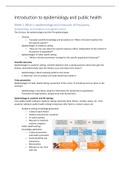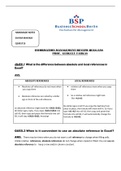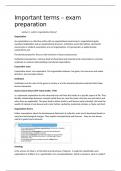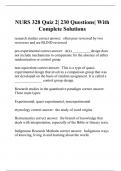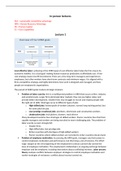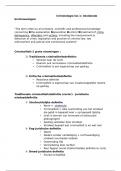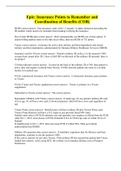Introduction to epidemiology and public health
Week 1 What is epidemiology and measures of frequency
Epidemiology: and academic and applied science
The clinician, the epidemiologist and the PH-epidemiologist
- Clinician
o Translate scientific knowledge and procedures to “What is the best treatment for
this specific patient?”
- Epidemiologist in academic setting
o “How can I be sure about this specific exposure-effect, independent of the context of
this person or population?”
- Epidemiologist in Public Health setting
o “What is the best prevention strategy for this specific population/risk group?”
Scientific detective
Epidemiologist in academic setting; scientific detective who is asking questions about who gets the
disease, when/where/why does the disease occur and what is the reason?
- Epidemiology is about analysing patterns and causes
- A ‘detective’ aims to analyse and understand these patterns
Crime prevention
Epidemiologist in Public Health setting; prevention of the crimes → should we lock our doors in the
evening?
- Epidemiology is also about using this information for prevention in populations
- Prevention through policies, programmes and interventions
Epidemiology in academic and PH settings
From public health setting to academic setting: eliminate other factors, context, values, etc. From
academic setting to public health setting incorporate other factors, context, values, etc.
- Academic setting: knowledge generation
o Is about causal factors
o Validity and precision, causation
o Et ceteris paribus
o Relevant to mankind,
anytime, anyplace
- Public Health setting:
knowledge application
o Is about prevention
and health promotion
o Generalizability and
importance
o Best practice
o Relevant to me, here
and now
,Epidemiology and public health is about health and disease in a population, before that it is about
nutrition, nutrients, habits and intake (smoking, being active, etc.). Figuring out what the responsible
factors are, you look at the production, food chain, social and build environment.
History of epidemiology and public health
Pre-formal epidemiology
1662 – pre-formal epidemiology
- Hygiene and sanitation
- People travelled all over the world
- Disease imported, exported, puerperal fever, cholera
- Group thinking started to emerge; infectious diseases
Early epidemiology
1900 – early epidemiology
- First professor in epidemiology at London School of Hygiene and Tropical Medicine (Major
Greenwood)
- Non-communicable diseases, pellagra, vitamins
Classical epidemiology
1940 – classical epidemiology
- Academic field in US and UK, TBC, tobacco smoke
- Methodology. Case-control, cohort, ecological, RCT, stratification and regression
- British doctors study
o Prospective cohort study from 1951 to 2001
o Provided convincing statistical proof in 1956 that tobacco smoking increased the risk
of lung cancer
Modern epidemiology
>1980 – modern epidemiology
- Theoretical basis in RCT, differentiation of expertise
- Prevention strategies (primary, secondary, tertiary)
Some triumphs in epidemiology
- Identification of water as a major reservoir and vehicle of communicable diseases such as
cholera and typhoid fever (1849-1856)
, - Identification of arthropod vectors (e.g., mosquitos, flies) for many diseases - malaria, yellow
fever, sleeping sickness (1895-1909)
- Cigarette smoking found to be major cause of lung cancer, emphysema, and cardiovascular
diseases (1951-1963)
- Identification of the AIDS syndrome and that it is caused by a sexually-transmitted virus
(1981-1983); N.B. Development of prevention measures before the virus was identified
Future of epidemiology
- Epidemiology provides knowledge about health and its determinants
- Provides foundation for Public Health interventions, policies and programmes
Epidemiology as foundation for public health.
Prevalence
Prevalence proportion
The prevalence proportion measures the proportion of people in a population who have the disease
at a given point in time:
𝑁𝑢𝑚𝑏𝑒𝑟 𝑜𝑓 𝑝𝑒𝑜𝑝𝑙𝑒 𝑤𝑖𝑡ℎ 𝑑𝑖𝑠𝑒𝑎𝑠𝑒 𝑎𝑡 𝑎 𝑔𝑖𝑣𝑒𝑛 𝑝𝑜𝑖𝑛𝑡 𝑖𝑛 𝑡𝑖𝑚𝑒
𝑃𝑟𝑒𝑣𝑎𝑙𝑒𝑛𝑐𝑒 𝑝𝑟𝑜𝑝𝑜𝑟𝑡𝑖𝑜𝑛 =
𝑇𝑜𝑡𝑎𝑙 𝑛𝑢𝑚𝑏𝑒𝑟 𝑜𝑓 𝑝𝑒𝑜𝑝𝑙𝑒 𝑖𝑛 𝑡ℎ𝑒 𝑝𝑜𝑝𝑢𝑙𝑎𝑡𝑖𝑜𝑛 𝑎𝑡 𝑡ℎ𝑒 𝑡𝑖𝑚𝑒
For example; what percentage/proportion of the population has a HIV infection right now?
- Global HIV prevalence = 0.8% (2018)
Point prevalence and period prevalence
- Point prevalence = number of adults with a disease on a specific time point
- Period prevalence = number of adults with a disease in a specific time period
Reflection questions
- Can you think of situations in which a point prevalence is preferred?
- When do you think a period prevalence is the better/more interesting choice?
Incidence
Incidence is about counting new cases (e.g. 1 million) and it measures how fast people are ‘catching’
the disease over a period in time (e.g. in one month/year).
It is expressed as:
- Proportion of people who develop the disease (e.g. 0.05 or 5%)
- Rate at which new cases of a disease have occurred (e.g. 5000 new cases per 100.000
persons per year)
Incidence proportion (IP)
Incidence proportion (or cumulative incidence (CI)) is the proportion of the population that develops
disease in a specified period (new cases):
𝑁𝑢𝑚𝑏𝑒𝑟 𝑜𝑓 𝑝𝑒𝑜𝑝𝑙𝑒 𝑤ℎ𝑜 𝑑𝑒𝑣𝑒𝑙𝑜𝑝 𝑑𝑖𝑠𝑒𝑎𝑠𝑒 𝑖𝑛 𝑎 𝑠𝑝𝑒𝑐𝑖𝑓𝑖𝑒𝑑 𝑝𝑒𝑟𝑖𝑜𝑑
𝐼𝑃 =
𝑁𝑢𝑚𝑏𝑒𝑟 𝑜𝑓 𝒑𝒆𝒐𝒑𝒍𝒆 𝒂𝒕 𝒓𝒊𝒔𝒌 𝑜𝑓 𝑔𝑒𝑡𝑡𝑖𝑛𝑔 𝑡ℎ𝑒 𝑑𝑖𝑠𝑒𝑎𝑠𝑒 𝑎𝑡 𝑡ℎ𝑒 𝑠𝑡𝑎𝑟𝑡 𝑜𝑓 𝑡ℎ𝑒 𝑝𝑒𝑟𝑖𝑜𝑑
, Example: 5 year survival after treatment for cervical cancer was 62%. We start with a group of
women, follow them for 5 years and account what happens in those 5 years.
- In 1 year 7 out of 12 persons develop a disease, so the average risk in
the population is 58%
- Assumes that entire population at risk is followed up for specified
time period
X = disease onset
Incidence rate (IR)
Incidence rate (or incidence density (ID)) is the number of new cases divided by person-time
experience of the population (~ mortality rate):
𝑁𝑢𝑚𝑏𝑒𝑟 𝑜𝑓 𝑝𝑒𝑜𝑝𝑙𝑒 𝑤ℎ𝑜 𝑑𝑒𝑣𝑒𝑙𝑜𝑝 𝑑𝑖𝑠𝑒𝑎𝑠𝑒 𝑖𝑛 𝑎 𝑠𝑝𝑒𝑐𝑖𝑓𝑖𝑒𝑑 𝑝𝑒𝑟𝑖𝑜𝑑
𝐼𝑅 =
𝑇𝑜𝑡𝑎𝑙 𝒑𝒆𝒓𝒔𝒐𝒏 − 𝒕𝒊𝒎𝒆 𝑤ℎ𝑒𝑛 𝑝𝑒𝑜𝑝𝑙𝑒 𝑤𝑒𝑟𝑒 𝒂𝒕 𝒓𝒊𝒔𝒌 𝑜𝑓 𝑔𝑒𝑡𝑡𝑖𝑛𝑔 𝑡ℎ𝑒 𝑑𝑖𝑠𝑒𝑎𝑠𝑒
Example: in 2018 the mortality rate in Dutch
women from myocardial infarction was 24.9 per
100.000 person-years.
Open versus closed population
- Closed population:
o Based on fixed membership
o Follow-up is complete
o No one can be added
o But people may die, lost to follow up, etc. → becomes smaller with time
o Everyone is followed
o Incidence proportion
o Incidence rate
o E.g. you taking this course this year or birth cohort
- Open or dynamic population:
o Different people come and go, but total numbers stay the same
o Can take new members with time
o No follow-up when leaving → follow-up is incomplete
o Incidence rate
o E.g. Wageningen Campus over time
Reflection questions
- What is more precise? An incidence proportion or an incidence rate?
- What is the difference between an open and a closed cohort?
Week 1 What is epidemiology and measures of frequency
Epidemiology: and academic and applied science
The clinician, the epidemiologist and the PH-epidemiologist
- Clinician
o Translate scientific knowledge and procedures to “What is the best treatment for
this specific patient?”
- Epidemiologist in academic setting
o “How can I be sure about this specific exposure-effect, independent of the context of
this person or population?”
- Epidemiologist in Public Health setting
o “What is the best prevention strategy for this specific population/risk group?”
Scientific detective
Epidemiologist in academic setting; scientific detective who is asking questions about who gets the
disease, when/where/why does the disease occur and what is the reason?
- Epidemiology is about analysing patterns and causes
- A ‘detective’ aims to analyse and understand these patterns
Crime prevention
Epidemiologist in Public Health setting; prevention of the crimes → should we lock our doors in the
evening?
- Epidemiology is also about using this information for prevention in populations
- Prevention through policies, programmes and interventions
Epidemiology in academic and PH settings
From public health setting to academic setting: eliminate other factors, context, values, etc. From
academic setting to public health setting incorporate other factors, context, values, etc.
- Academic setting: knowledge generation
o Is about causal factors
o Validity and precision, causation
o Et ceteris paribus
o Relevant to mankind,
anytime, anyplace
- Public Health setting:
knowledge application
o Is about prevention
and health promotion
o Generalizability and
importance
o Best practice
o Relevant to me, here
and now
,Epidemiology and public health is about health and disease in a population, before that it is about
nutrition, nutrients, habits and intake (smoking, being active, etc.). Figuring out what the responsible
factors are, you look at the production, food chain, social and build environment.
History of epidemiology and public health
Pre-formal epidemiology
1662 – pre-formal epidemiology
- Hygiene and sanitation
- People travelled all over the world
- Disease imported, exported, puerperal fever, cholera
- Group thinking started to emerge; infectious diseases
Early epidemiology
1900 – early epidemiology
- First professor in epidemiology at London School of Hygiene and Tropical Medicine (Major
Greenwood)
- Non-communicable diseases, pellagra, vitamins
Classical epidemiology
1940 – classical epidemiology
- Academic field in US and UK, TBC, tobacco smoke
- Methodology. Case-control, cohort, ecological, RCT, stratification and regression
- British doctors study
o Prospective cohort study from 1951 to 2001
o Provided convincing statistical proof in 1956 that tobacco smoking increased the risk
of lung cancer
Modern epidemiology
>1980 – modern epidemiology
- Theoretical basis in RCT, differentiation of expertise
- Prevention strategies (primary, secondary, tertiary)
Some triumphs in epidemiology
- Identification of water as a major reservoir and vehicle of communicable diseases such as
cholera and typhoid fever (1849-1856)
, - Identification of arthropod vectors (e.g., mosquitos, flies) for many diseases - malaria, yellow
fever, sleeping sickness (1895-1909)
- Cigarette smoking found to be major cause of lung cancer, emphysema, and cardiovascular
diseases (1951-1963)
- Identification of the AIDS syndrome and that it is caused by a sexually-transmitted virus
(1981-1983); N.B. Development of prevention measures before the virus was identified
Future of epidemiology
- Epidemiology provides knowledge about health and its determinants
- Provides foundation for Public Health interventions, policies and programmes
Epidemiology as foundation for public health.
Prevalence
Prevalence proportion
The prevalence proportion measures the proportion of people in a population who have the disease
at a given point in time:
𝑁𝑢𝑚𝑏𝑒𝑟 𝑜𝑓 𝑝𝑒𝑜𝑝𝑙𝑒 𝑤𝑖𝑡ℎ 𝑑𝑖𝑠𝑒𝑎𝑠𝑒 𝑎𝑡 𝑎 𝑔𝑖𝑣𝑒𝑛 𝑝𝑜𝑖𝑛𝑡 𝑖𝑛 𝑡𝑖𝑚𝑒
𝑃𝑟𝑒𝑣𝑎𝑙𝑒𝑛𝑐𝑒 𝑝𝑟𝑜𝑝𝑜𝑟𝑡𝑖𝑜𝑛 =
𝑇𝑜𝑡𝑎𝑙 𝑛𝑢𝑚𝑏𝑒𝑟 𝑜𝑓 𝑝𝑒𝑜𝑝𝑙𝑒 𝑖𝑛 𝑡ℎ𝑒 𝑝𝑜𝑝𝑢𝑙𝑎𝑡𝑖𝑜𝑛 𝑎𝑡 𝑡ℎ𝑒 𝑡𝑖𝑚𝑒
For example; what percentage/proportion of the population has a HIV infection right now?
- Global HIV prevalence = 0.8% (2018)
Point prevalence and period prevalence
- Point prevalence = number of adults with a disease on a specific time point
- Period prevalence = number of adults with a disease in a specific time period
Reflection questions
- Can you think of situations in which a point prevalence is preferred?
- When do you think a period prevalence is the better/more interesting choice?
Incidence
Incidence is about counting new cases (e.g. 1 million) and it measures how fast people are ‘catching’
the disease over a period in time (e.g. in one month/year).
It is expressed as:
- Proportion of people who develop the disease (e.g. 0.05 or 5%)
- Rate at which new cases of a disease have occurred (e.g. 5000 new cases per 100.000
persons per year)
Incidence proportion (IP)
Incidence proportion (or cumulative incidence (CI)) is the proportion of the population that develops
disease in a specified period (new cases):
𝑁𝑢𝑚𝑏𝑒𝑟 𝑜𝑓 𝑝𝑒𝑜𝑝𝑙𝑒 𝑤ℎ𝑜 𝑑𝑒𝑣𝑒𝑙𝑜𝑝 𝑑𝑖𝑠𝑒𝑎𝑠𝑒 𝑖𝑛 𝑎 𝑠𝑝𝑒𝑐𝑖𝑓𝑖𝑒𝑑 𝑝𝑒𝑟𝑖𝑜𝑑
𝐼𝑃 =
𝑁𝑢𝑚𝑏𝑒𝑟 𝑜𝑓 𝒑𝒆𝒐𝒑𝒍𝒆 𝒂𝒕 𝒓𝒊𝒔𝒌 𝑜𝑓 𝑔𝑒𝑡𝑡𝑖𝑛𝑔 𝑡ℎ𝑒 𝑑𝑖𝑠𝑒𝑎𝑠𝑒 𝑎𝑡 𝑡ℎ𝑒 𝑠𝑡𝑎𝑟𝑡 𝑜𝑓 𝑡ℎ𝑒 𝑝𝑒𝑟𝑖𝑜𝑑
, Example: 5 year survival after treatment for cervical cancer was 62%. We start with a group of
women, follow them for 5 years and account what happens in those 5 years.
- In 1 year 7 out of 12 persons develop a disease, so the average risk in
the population is 58%
- Assumes that entire population at risk is followed up for specified
time period
X = disease onset
Incidence rate (IR)
Incidence rate (or incidence density (ID)) is the number of new cases divided by person-time
experience of the population (~ mortality rate):
𝑁𝑢𝑚𝑏𝑒𝑟 𝑜𝑓 𝑝𝑒𝑜𝑝𝑙𝑒 𝑤ℎ𝑜 𝑑𝑒𝑣𝑒𝑙𝑜𝑝 𝑑𝑖𝑠𝑒𝑎𝑠𝑒 𝑖𝑛 𝑎 𝑠𝑝𝑒𝑐𝑖𝑓𝑖𝑒𝑑 𝑝𝑒𝑟𝑖𝑜𝑑
𝐼𝑅 =
𝑇𝑜𝑡𝑎𝑙 𝒑𝒆𝒓𝒔𝒐𝒏 − 𝒕𝒊𝒎𝒆 𝑤ℎ𝑒𝑛 𝑝𝑒𝑜𝑝𝑙𝑒 𝑤𝑒𝑟𝑒 𝒂𝒕 𝒓𝒊𝒔𝒌 𝑜𝑓 𝑔𝑒𝑡𝑡𝑖𝑛𝑔 𝑡ℎ𝑒 𝑑𝑖𝑠𝑒𝑎𝑠𝑒
Example: in 2018 the mortality rate in Dutch
women from myocardial infarction was 24.9 per
100.000 person-years.
Open versus closed population
- Closed population:
o Based on fixed membership
o Follow-up is complete
o No one can be added
o But people may die, lost to follow up, etc. → becomes smaller with time
o Everyone is followed
o Incidence proportion
o Incidence rate
o E.g. you taking this course this year or birth cohort
- Open or dynamic population:
o Different people come and go, but total numbers stay the same
o Can take new members with time
o No follow-up when leaving → follow-up is incomplete
o Incidence rate
o E.g. Wageningen Campus over time
Reflection questions
- What is more precise? An incidence proportion or an incidence rate?
- What is the difference between an open and a closed cohort?

